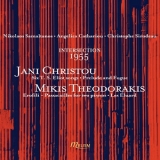 Intersection 1955; Mikis Theodorakis: Erofili, Passacailles pour deux pianos + Les Éluard; Jani Christou: Six T. S. Eliot Songs for mezzo-soprano and piano + Prelude and Fugue in D minor for Two Pianos; Nikolaos Samaltanos & Christophe Sirodeau, Klavier, Angelica Cathariou, Mezzosopran; 1 CD Melism Records MLSCD026; Aufnahmen 2017/2018, Veröffentlichung 28/08/2020 (67') - Rezension von Remy Franck
Intersection 1955; Mikis Theodorakis: Erofili, Passacailles pour deux pianos + Les Éluard; Jani Christou: Six T. S. Eliot Songs for mezzo-soprano and piano + Prelude and Fugue in D minor for Two Pianos; Nikolaos Samaltanos & Christophe Sirodeau, Klavier, Angelica Cathariou, Mezzosopran; 1 CD Melism Records MLSCD026; Aufnahmen 2017/2018, Veröffentlichung 28/08/2020 (67') - Rezension von Remy Franck
Die CD Intersection:1955 stellt Kompositionen von zwei griechischen Komponisten gegenüber. Außer Cristous Eliot-Liedern handelt es sich um Weltersteinspielungen, was allein schon der Veröffentlichung eine große Bedeutung gibt.
Mikis Theodorakis komponierte seine Passacailles pour deux pianos für ein Ballett mit dem Titel Erofili. Er studierte damals noch in Paris bei Eugène Bigot und Olivier Messiaen, und diese Musik ist eigentlich gar nicht typisch für ihn. Die Klaviere werden sehr perkussiv und rhythmisch eingesetzt, was die beiden Interpreten,
Nikolaos Samaltanos und Christophe Sirodeau, nicht daran hindert, die kontrastreiche Musik sehr klangvoll und quasi klaviersymphonisch zu spielen.
Danach sind zwei Liederzyklen zu hören, die Theodorakis 1958 auf Texte von Paul Eluard komponierte. Sie sind für jeden, der sich mit der Musik von Theodorakis befasst, eine regelrechte Entdeckung. Der Text wechselt zwischen feinster Melodik und Sprechgesang über einem sehr sparsamen, rhythmischen, klaren und dennoch stimmungsmachenden Klavierpart. Angelica Cathariou und Nikolaos Samaltanos gelingt mit nuancenreichem Interpretieren eine unmittelbar ansprechende Darbietung.
Der griechische Komponist Jani Christou (1926 -1970), der Klavier u.a. bei der berühmten Gina Bachauer, Komposition und Philosophie studiert hatte, war auf dem Höhepunkt seines Schaffens, als er 1970 an seinem 44. Geburtstag bei einem Verkehrsunfall in Athen ums Leben kam. Seine Eliot-Lieder entstanden 1955 und
gehören zur ersten, atonalen Phase seines Schaffens. Die Lieder sind viel dramatischer als die von Theodorakis und setzen die Atmosphäre der Texte bedeutungsvoll um. Die Lieder werden von Cathariou und Samaltanos mit größter Ausdruckskraft interpretiert.
Nikolaos Samaltanos und Christophe Sirodeau spielen dann noch das neoklassische, zwischen Tonalität und Atonalität schwankende Präludium und Fuge von Christou und überzeugen in diesem etwa acht Minuten langen Stück mit einem fein differenzierten Spiel.
The CD Intersection:1955 comprises compositions by two Greek composers. Apart from Cristous Eliot songs, these are world premiere recordings, which gives the release a great significance.
Mikis Theodorakis composed his Passacailles pour deux pianos for a ballet entitled Erofili. At that time he was still studying in Paris with Eugène Bigot and Olivier Messiaen, and this music is not really typical of him. The pianos are used very percussively and rhythmically, but this does not prevent Nikolaos Samaltanos and Christophe Sirodeau from playing the contrasting music very sonorously and even, so to say, piano-symphonically.
The two song cycles were composed by Theodorakis in 1958 on texts by Paul Eluard. They are a real discovery for anyone interested in Theodorakis’ music. The lyrics alternate between the finest melody and sprechgesang over a very sparse, rhythmic, clear and yet atmospheric piano part. Angelica Cathariou and Nikolaos Samaltanos succeed in creating an immediately appealing performance with nuanced interpretations.
The Greek composer Jani Christou (1926 -1970), who studied piano with the famous Gina Bachauer, composition and philosophy, among others, was at the height of his creative powers when he died in a traffic accident in Athens in 1970, just on his 44th birthday. His Eliot songs were written in 1955 and belong to the first, atonal phase of his work. The songs are much more dramatic than those of Theodorakis and translate the atmosphere of the texts meaningfully. The songs are interpreted by Cathariou and Samaltanos with great expressiveness.
Nikolaos Samaltanos and Christophe Sirodeau then play Christou’s neo-classical Prelude and Fugue, which fluctuates between tonality and atonality. The pianists convince in this approximately eight-minute-long piece with a finely differentiated playing.
























